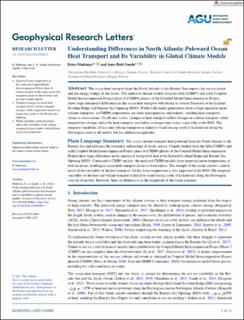Understanding differences in North Atlantic poleward ocean heat transport and its variability in global climate models
Journal article, Peer reviewed
Published version

Åpne
Permanent lenke
https://hdl.handle.net/11250/2890304Utgivelsesdato
2021Metadata
Vis full innførselSamlinger
- Geophysical Institute [1198]
- Registrations from Cristin [9791]
Sammendrag
The ocean heat transport from the North Atlantic to the Barents Sea impacts the sea ice extent and the energy budget of the Arctic. The analyzed climate models from the fifth (CMIP5) and sixth Coupled Model Intercomparison Project phase 6 (CMIP6) phases of the Coupled Model Intercomparison Project show large intermodel differences in the ocean heat transport with biases of several Terawatts at the Iceland-Scotland Ridge and Barents Sea Opening (BSO). While both model generations show a large spread in mean volume transports, in CMIP6 temperatures are more homogeneous and realistic, yielding heat transports closer to observations. On all time scales, changes in heat transport reflect changes in volume transport, while temperature changes affect the heat transport variability on longer time scales, especially at the BSO. The temporal variability of heat and volume transports is linked to wind forcing south of Iceland and along the Norwegian coast in all models but has different magnitudes.
